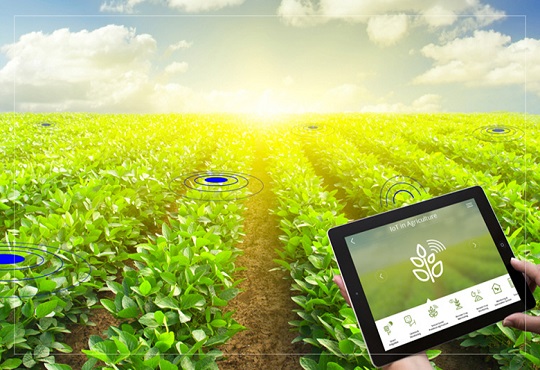Harnessing the Power of IoT in Agriculture: Enhancing Monitoring and Management
Janifha Evangeline | Sunday, 06 August 2023, 20:17 IST

The Internet of Things (IoT) has become widely used, and connected devices are now present in every aspect of our life, from industrial IoT to smart cities, from home automation to transportation and logistics. Therefore, it makes perfect sense that the Internet of Things, networked gadgets, and automation would find their way into agriculture and significantly enhance almost every part of it. How could anyone still use horses and ploughs when technologies like virtual reality and self-driving cars are no longer science fiction concepts but rather everyday occurrences?
Farming has changed significantly technologically over the past few decades, becoming more industrialised and reliant on technology. Utilising a variety of smart agricultural technology, farmers have enhanced control over the process of raising livestock and growing crops, making it more predictable and efficient. This has aided in the global adoption of smart farming technologies, along with growing consumer demand for agricultural goods. The market share for IoT in agriculture in 2022 will be $13.76 billion. Both specific IoT apps for agriculture and other IoT sensor types are available. In this article let us look at how IoT in agriculture is enhancing monitoring and management in the sector.
Monitoring of Climatic conditions
The most common smart agriculture devices are undoubtedly weather stations, which have a variety of smart agricultural sensors. They are dispersed around the area and collect various types of environmental data before uploading it to the cloud. With the help of the measurements, it is possible to map the climate, choose the best crops, and take the necessary actions to maximise their productivity (also known as precision farming). Examples of IoT equipment used in agriculture include AllMETEO, Smart Elements, and Pycno.
Greenhouse Automation
Typically, farmers need manual intervention to regulate the greenhouse's temperature. Using IoT sensors, they could get precise real-time data on greenhouse aspects including lighting, temperature, soil quality, and humidity.
In addition to acquiring environmental data, weather stations have the ability to automatically change the environment to reflect the given parameters. Automation solutions for greenhouses operate on a similar principle. Examples of IoT agriculture technologies with similar features include Farmapp and Growlink.
Crop management
Another type of IoT product used in agriculture and a part of precision farming is crop management equipment. They should be set up in the field, just like weather stations, to record information relevant to each crop, such as temperature and precipitation, as well as leaf water potential and overall crop health.
By keeping an eye on crop growth and any anomalies, you may effectively prevent infections and infestations that could harm your productivity. Good examples of how to use this use case in practise are Arable and Semios.
Cattle Monitoring and Management
IoT agricultural sensors can be added to farm animals to track performance and monitor their health, similar to crop monitoring. Data on the condition, welfare, and physical location of animals are gathered with the use of livestock tracking and monitoring.
For example, these sensors may spot sick animals and keep them apart from the herd to avoid spreading disease. Using drones to track livestock in real time also saves farms money on labour. IoT pet care gadgets function in a manner similar to this. Another illustration is SCR by Allflex and Cowlar, which employs smart agricultural sensors (collar tags) to provide data on the temperature, well-being, activity, and nutrition of each individual cow in addition to details on the entire herd.
Precision farming
Precision farming, another name for precision agriculture, is all about efficiency and making the best data-driven choices. It's also one of the most well-liked and practical IoT applications in agriculture. Farmers can collect a wide range of metrics, such as data on lighting, temperature, soil quality, humidity, CO2 levels, and insect infestations, using IoT devices to study the microclimate and ecology of their farms. Farmers can save money while producing better and healthier harvests by using this knowledge to predict how much water, fertiliser, and pesticides their crops will require. For instance, the IoT soil sensors created by CropX assess the soil's temperature, electric conductivity, and moisture content, allowing farmers to adapt their practises to the particular needs of each crop.
Agricultural drones
The use of agricultural drones in smart farming is one of the most exciting advancements in agritech. Drones, as opposed to satellites and aircraft, are better suited to collect agricultural data. In addition to surveillance, drones can now do a number of jobs that formerly needed human labour, such as crop monitoring, pest and disease management, agricultural spraying, and more.
For instance, DroneSeed creates drones for planting trees in barren landscapes. Such drones are six times more productive than human labour. The eBee SQ from Sense Fly is a cost-effective agriculture drone that uses multispectral image analysis to assess crop health.
The introduction of cutting-edge technical solutions to time-tested knowledge has been made possible by IoT-enabled agriculture. As a result, the gap between production, quality, and quantity yield has decreased. By receiving and importing information from numerous sensors for use in real-time or storage in a database, data ingestion enables prompt action and minimal crop damage. Because of seamless end-to-end intelligent operations and superior business process execution, produce is processed more quickly and supplied to supermarkets in less time.




